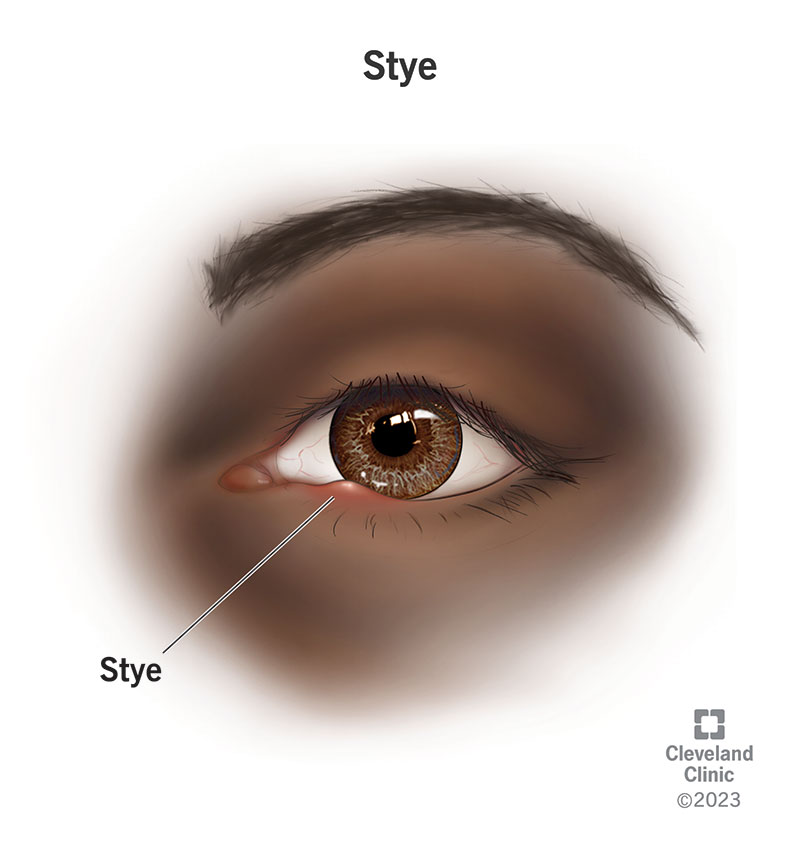A stye is a painful red bump on the edge of your eyelid. Similar to an acne pimple, a stye forms when a tiny oil gland near your eyelashes becomes blocked and gets infected. Styes are very common, and in many cases, you can manage them at home. But some cases may require treatment by an eye care provider.
Advertisement
Cleveland Clinic is a non-profit academic medical center. Advertising on our site helps support our mission. We do not endorse non-Cleveland Clinic products or services. Policy

A stye (or sty) is a painful red bump on the edge of your eyelid. It can look similar to an acne pimple and may be tender to the touch. A stye forms when a tiny oil-producing gland in your eyelash follicle or eyelid skin becomes blocked and a bacterial infection develops. The medical term for a stye is “hordeolum.”
Advertisement
Cleveland Clinic is a non-profit academic medical center. Advertising on our site helps support our mission. We do not endorse non-Cleveland Clinic products or services. Policy
It’s common to have a stye on only one eyelid, but it’s also possible to get styes on both lids. A stye usually lasts one to two weeks and will typically go away on its own. But in cases where it doesn’t, you may need to rely on an eye care provider to drain it. They may also prescribe antibiotics to reduce the infection.
A stye is similar to another eyelid bump called a chalazion. A chalazion is a bump that usually occurs farther back on your eyelid. Unlike a stye, a chalazion usually isn’t painful and isn’t caused by a bacterial infection. But treatment for both conditions is similar.
There are two types of styes:
Styes are very common. They’re more common in adults than children because the oil in an adult’s oil glands is thicker than a child’s. That means it’s more prone to blockage.
The main symptom of a stye is a painful red bump along your eyelid edge near your eyelashes. Other stye symptoms may include:
Advertisement
A bacterial infection in your eyelid’s oil-producing glands causes most styes. The oil-producing glands line the eyelids and help lubricate the surface of your eye.
Styes generally aren’t contagious. But small amounts of bacteria can be spread from them. This is why it’s important to always wash your hands before and after touching a stye and wash pillowcases often to help prevent the bacteria from spreading. Unless you’re cleaning or applying warm compresses to the stye, avoid touching it to reduce bacteria spread and irritation.
Styes are very common, and anyone can get them. But you may be more likely to get a stye if you:
Some styes are more stubborn and require a visit to a healthcare provider. If your vision seems to be affected or if your stye seems to be getting worse instead of better, contact a provider.
During your appointment, your provider will examine your eyelid and ask about any additional symptoms you’re having. They’ll be able to diagnose a stye based on this eye exam.
A stye will usually go away by itself in one to two weeks. To feel better faster and reduce pain and swelling, you can use a self-care plan to treat your stye at home. Here are some dos and don’ts to manage your stye at home.
Advertisement
If after 48 hours of stye self-care, your pain and swelling aren’t getting any better, it’s time to call your eye care provider. Stye treatment by a medical provider may include:
Styes are usually harmless. They may cause some minor irritation and discomfort, but they typically go away on their own. Stye self-care measures like warm compresses can help speed up the healing process.
Although it will be tempting to cover the stye with makeup, avoid doing this. Putting makeup on a stye can delay the healing process or even cause it to become more plugged up and infected, which, in turn, will make it more painful.
The best way to prevent a stye is to practice good facial hygiene, including:
Advertisement
You should see your healthcare provider if:
If you have a stye, you may want to ask your provider the following questions:
Ouch! What’s that painful red bump that’s developed on your eye? A common cause is a stye. Though they can be painful, most styes aren’t a cause for concern. Having a stye is usually manageable with good eyelid hygiene, and most cases will go away on their own. If the stye persists and doesn’t seem to be getting any better with at-home treatment, contact an eye care specialist.
Advertisement
Cleveland Clinic’s ophthalmologists and optometrists have the highest training available. We provide exams, vision correction and care for many eye conditions.

Last reviewed on 12/21/2023.
Learn more about the Health Library and our editorial process.